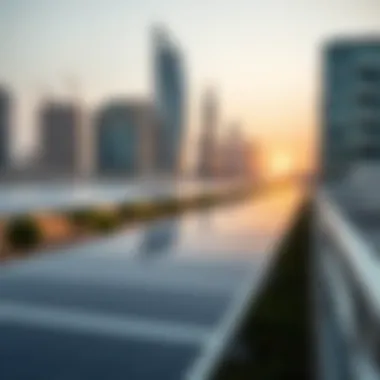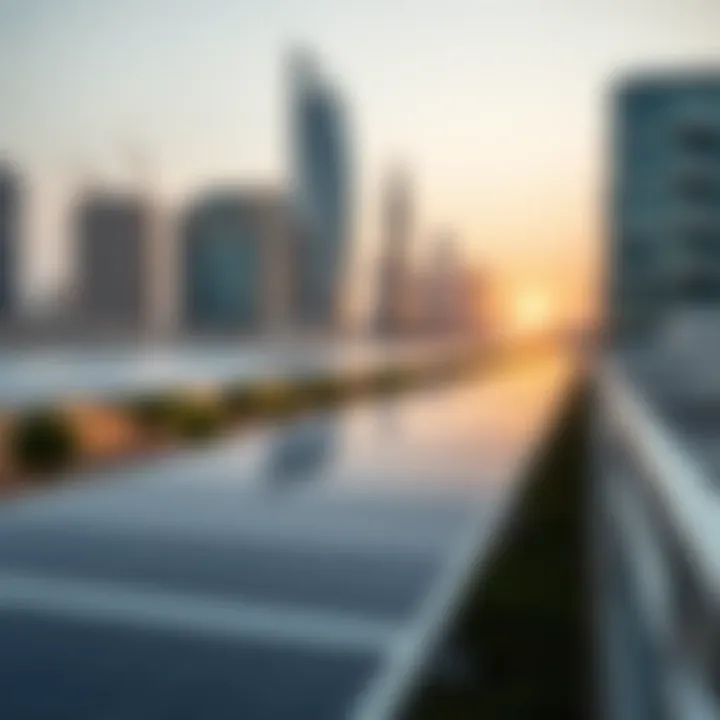Exploring Masdar City: A Model for Sustainable Living


Intro
Masdar City is not just another urban development; it is a bold reflection of what the future could be like when innovation meets environmental consciousness. Located in the heart of Abu Dhabi, it paves the way for sustainable living through its comprehensive integration of renewable energy and smart technologies. This visionary project is a testament to what can be achieved when the ambition to create greener spaces aligns with urban planning.
As we delve deeper into Masdar City, we will examine its overarching vision, unique architectural methods, and cutting-edge technological systems that ensure energy efficiency and resource optimization. Furthermore, we'll discuss how these elements link to the broader context of urban planning, sustainability, and what lessons can be learned from this groundbreaking initiative. The article is not just for those interested in green architecture but also for those involved in investment and development opportunities as it explores future prospects within Masdar City.
Prolusion to Masdar City
Masdar City represents a bold leap forward in the field of sustainable urban development. Nestled in the heart of Abu Dhabi, this ambitious project aims not only to create a modern urban landscape but also serves as a living laboratory for sustainable practices and innovative technologies. The significance of discussing Masdar City cannot be overstated, as it embodies the convergence of eco-conscious design, technological advancement, and social innovation. In a world grappling with climate change and the pressing need for sustainable living, Masdar City is often viewed as a potential blueprint for future cities.
Key elements worth examining include its unique approach to renewable energy, its smart city initiatives, and the intricate balance of community engagement alongside technological developments. The benefits of such a project extend beyond mere aesthetics. They encompass economic diversification, job creation, and community well-being, all of which play a vital role in shifting the narrative around urban living.
Moreover, Masdar City is not without its challenges. Questions around financial viability, technological limitations, and public engagement present hurdles that require careful navigation. By understanding these complexities, we can appreciate the depth of Masdar City as not just an urban project but a pioneering attempt at redefining livable spaces.
Location and Geographic Context
Masdar City is strategically positioned just 17 kilometers from downtown Abu Dhabi, making it remarkably accessible yet distinct. This proximity allows for easy interaction with the larger urban environment while establishing a unique identity focused on sustainability. Its location in the Arabian Gulf region places it in an area known for both natural beauty and extreme climates. The city’s planning incorporates these factors, leveraging them into its design.
The site’s sandy, arid landscape has informed many of its architectural choices, emphasizing building designs that minimize heat gain and maximize natural ventilation. Furthermore, being situated in a region with high solar irradiation offers an advantageous platform for harnessing solar energy, thus aligning with its mission of zero-carbon living. Residents and businesses alike benefit from this geographical context, as it not only enhances the quality of life but also underscores the endeavor's sustainability goals.
Historical Background and Development
The inception of Masdar City dates back to 2006 when the Abu Dhabi government sought to establish a model for sustainable urban living. The initiative stemmed from the recognition that urban growth must harmonize with environmental stewardship. Thus, Masdar City was envisioned as a place where sustainability principles are woven into the very fabric of urban life.
The development has followed a phased approach, with initial construction focused on infrastructure and foundational systems, which set the stage for future buildings and community spaces. Collaborations with various international firms and local stakeholders have marked its progress, resulting in innovations that include sustainable architecture, energy efficiency technology, and a focus on reducing carbon footprints.
As of recent years, much of the developmental narrative has revolved around the gradual transformation of Masdar City from a construction zone into a vibrant urban habitat. The goal has always been to create a space that becomes not just a place to live but a vibrant community advocating for sustainable practices. This evolving history serves as an educational backdrop for urban planners and environmentalists across the globe, highlighting both achievements and learning opportunities along the way.
"The vision for Masdar City is not merely about construction but setting a new paradigm in urban planning that integrates the environment with modern living."
From its conceptual roots to its ongoing growth, Masdar City stands as a testament to what can be achieved when innovation meets ambition. This narrative of transformation will not only inform today's readers but also spark conversations regarding the future possibilities for urban development.
Core Concepts of Masdar City
Understanding the core concepts that drive Masdar City is essential for grasping its role in sustainable urban development. This city is not just a project; it represents a shift in how communities can harmonize with the environment. By looking deeply at the principles behind its creation, we get insight into the potential benefits and how they address pressing global issues such as climate change, resource management, and urbanization challenges.
Sustainable Urban Design Principles
At the heart of Masdar City's design are principles that prioritize sustainability. This city's layout is tailored to minimize energy use while maximizing ecological efficiency. Streets are designed to encourage pedestrian movement, with shaded pathways that help combat the sizzling desert heat. In essence, the concept aims to create a liveable space where community interaction flourishes, yet the environmental footprint remains minimal.
Key Features of Sustainable Design:
- Compactness: Masdar is built to be walkable, reducing reliance on cars and fostering a sense of community.
- Natural Lighting: Buildings are strategically oriented, ensuring that the natural sun illuminates workplaces and homes, saving energy.
- Green Spaces: Parks and community gardens are interwoven, offering residents not just a place to gather but also promoting biodiversity.
"Sustainable urban design in Masdar City serves as a blueprint, showcasing how thoughtfully planned spaces can coexist with nature without compromise."
These design elements contribute to a healthier lifestyle for residents while lowering emissions. Additionally, they serve practical purposes, from conserving water through native landscaping to integrating features like greywater systems, which treat and recycle water for irrigation.
Zero Carbon and Zero Waste Goals
Masdar City pursues the ambitious targets of zero carbon emissions and zero waste production. These goals are not mere phrases but rather core guidelines that drive every aspect of the city’s development. They form the backbone of Masdar’s identity as a leader in the quest for sustainable lifestyles.
Understanding these goals requires acknowledging the challenges they present. Scholars and practitioners often discuss the feasibility of such targets, but Masdar demonstrates that innovation and commitment can lead to transformative solutions. By generating energy through renewable sources like solar panels, Masdar aims to generate more energy than it consumes, a significant milestone in current urban planning.


Key Strategies for Achieving Zero Carbon and Zero Waste:
- Renewable Energy Integration: A strong emphasis on solar infrastructure and energy-efficient buildings.
- Circular Economy Practices: The use of recycled materials in construction and a commitment to minimizing waste generation throughout the city.
- Community Awareness Programs: Educating residents about sustainability practices and encouraging active participation in waste reduction initiatives.
In summary, the core concepts underlying Masdar City illustrate a profound shift towards sustainable living. By incorporating advanced design principles and striving for ambitious environmental targets, the city not only paves the way for future urban environments but also influences broader practices around the globe. Investors and urban planners alike can glean significant insights from Masdar's journey and consider how such principles can be applied elsewhere.
Innovative Technologies within Masdar City
Masdar City stands at the cutting edge of sustainable urban development by integrating innovative technologies that redefine environmental sustainability. The city's design revolves around renewable resources and smart infrastructures, playing a vital role in achieving its green goals. These technologies are not just for show; they are fundamental to shaping how urban areas can coexist with nature, providing a blueprint other cities might follow.
Renewable Energy Sources
Solar Power Initiatives
Masdar City has taken significant strides in implementing solar power initiatives that contribute greatly to its vision of sustainability. This initiative is characterized by large-scale solar panels designed to harness the abundant sunlight that the Abu Dhabi desert offers. Solar power here is not merely an option but a solution that fits right into the larger aim of becoming a zero-carbon city.
One unique feature of its solar endeavors is the integration of photovoltaic cells into building materials, allowing for energy production without requiring additional space. This not only maximizes energy generation but also showcases how aesthetically pleasing designs can complement functional requirements.
Nevertheless, relying heavily on solar energy isn’t without its challenges. The initial costs of installation and maintenance, along with the need for technological advancements to increase efficiency, can be hurdles. Yet, the long-term benefits, including reduced utility costs and environmental impact, make it a favorable choice for Masdar City’s future.
Wind Energy Utilization
Wind energy utilization is another pillar supporting Masdar City’s sustainable structure. This initiative is based on the key characteristic of leveraging natural wind patterns to generate energy, positioning wind turbines in strategic locations that maximize efficiency. These turbines provide a renewable energy source that complements solar power, ensuring a diversified energy portfolio.
What’s unique about wind energy here is the focus on small to medium-sized turbines that can be integrated into the urban landscape without dominating it. This approach not only reduces the visual impact but also engages the community in renewable energy initiatives, fostering a culture of sustainability.
However, like solar power, wind energy has its limitations. The efficiency can vary significantly with weather patterns and geographic factors, which may reduce its reliability compared to other sources. Yet, the synergy between solar and wind creates resilience in energy production, benefiting Masdar City as it pushes towards its sustainability goals.
Smart Transportation Solutions
Public Transit Systems
The public transit systems in Masdar City are designed to introduce an advanced approach to urban mobility. The transport system is a blend of efficiency and sustainability, with electric buses and light rail systems providing congestion-free travel. This characteristic makes the public transit choices highly beneficial for the overall urban planning scheme, targeting reduced carbon footprints.
One unique aspect of Masdar City’s public transit is the seamless integration of these systems with the city layout, ensuring accessibility from all residential and commercial areas. The design not only promotes ease of movement but encourages residents to prefer public transportation over personal vehicles, effectively reducing traffic congestion.
However, transitioning to such systems comes with challenges such as ensuring consistent service frequency and maintaining infrastructure. Despite these hurdles, the environmental benefits and the promotion of community interaction through shared transport make it a worthy focus.
Personal Mobility Options
In addition to public transit, personal mobility options are a critical part of the transportation strategy in Masdar City. This includes electric scooters and bicycles that provide convenient ways for residents to navigate short distances. The attempt to encourage low-carbon options for personal transport reflects an understanding of contemporary lifestyle needs while aiming for environmental responsibility.
What stands out about these personal mobility options is their user-centric design. Well-planned bike lanes and charging stations for electric scooters are prevalent, ensuring that residents find them a practical choice. This also aligns well with global trends toward personal electric vehicles and micro-mobility, creating alignment within urban transport modes.
Nevertheless, these initiatives demand continuous education and infrastructure investment. Safety and maintenance are paramount, requiring constant engagement from the city planners and residents alike. That said, personal mobility solutions significantly contribute to reducing dependence on fossil fuels and promoting a cleaner urban experience.
In summary, the innovative technologies embedded within Masdar City serve as a testament to what urban development can achieve when sustainability is at its core. Through renewable energy sources and smart transportation solutions, Masdar City molds itself into a living laboratory for sustainable practices.
Economic Impacts of Masdar City
The economic implications of Masdar City extend far beyond its borders, creating a model for integrating sustainability into urban growth. Its innovative approach not only attracts investments but also generates jobs and fosters economic variety. The economic strategy adopted by this city demonstrates a clear correlation between urban design and long-term financial growth, making it a groundbreaking case study in regional economics.
Attracting Investments
One of the critical achievements of Masdar City is its ability to become a magnet for foreign investments. Investors are increasingly interested in sustainable ventures, and Masdar serves as a shining beacon in this regard. The city has attracted renowned organizations and venture capital that focus on renewable energy and sustainable technologies. This influx of capital results from several elements:


- Strategic Location: Nestled in Abu Dhabi, a major global business hub, Masdar City benefits from proximity to key markets and a robust infrastructure.
- Government Support: The Emirati government has made substantial commitments, providing funding, incentives, and supportive policies that create a conducive environment for investment.
- Visionary Leadership: The smart city concept is firmly rooted in the vision of its founders, who understand the balance between profitability and environmental impact.
These factors make Masdar not just a project, but a compelling narrative that enhances investor confidence. When contrasted with cities that lack such integrated support systems, it becomes clear why Masdar is performing so well in attracting global funds.
Job Creation and Economic Diversification
Beyond investment attraction, Masdar City presents a wealth of job opportunities, directly influencing the regional economy. Employment opportunities are not limited to construction jobs but spread across diverse sectors. The city has taken significant steps to cultivate a labor force adept in sustainable practices, aligning with its overall mission. Consider these notable aspects:
- Diverse Employment Options: From researchers tackling renewable energy challenges to roles in public services and technology management, the jobs created cater to a wide spectrum of talent.
- Training and Education Initiatives: Structures like the Masdar Institute of Science and Technology help mold skilled professionals, linking education to real-world applications in sustainability.
- Economic Growth through Diversification: As a center focused on science and technology, Masdar enhances the regional economy by promoting industries such as clean technology, research, and innovation.
In closing, the economic impacts of Masdar City underscore the potential of sustainable urban development to transform not just a locality but an entire region. As countries worldwide grapple with environmental concerns and economic volatility, the lessons learned from Masdar's pioneering approach could shape future urban landscapes.
"Masdar City is more than an urban development; it’s a blueprint for how cities around the world can grow sustainably while boosting their economies."
This model of smart investments and job creation can act as a catalyst for wider adoption of sustainable practices in urban planning globally, reflecting an evolution in thought regarding the relationship between environmental stewardship and economic prosperity.
For further insights, you may explore resources at Wikipedia, Britannica and communities discussing related topics on Reddit.
Social Aspects of Masdar City
The social dimensions of Masdar City are instrumental in understanding its role as a pioneering model for sustainable urban living. Beyond its impressive technological advancements and energy-efficient designs, Masdar City places a significant emphasis on building a community that fosters collaboration, well-being, and education. This aspect of urban development not only contributes to the quality of life of its residents but also sets a precedent for future cities to adopt a more social-focused approach in their planning.
Community Engagement and Participation
At the heart of Masdar City's social structure is the concept of inclusive community engagement. This isn't just about having meetings and consultations; it's about actively involving residents in the decision-making processes that affect their home. While many urban developments operate on a top-down approach, Masdar City has established platforms for inhabitants to voice their opinions. Regular workshops, community forums, and digital platforms allow community participation in various stages of planning and development. This sense of ownership and empowerment cultivates a vibrant community spirit.
An example of this participatory approach can be seen in the creation of green spaces and communal areas. Residents have been encouraged to contribute ideas on the types of facilities and services they wish to see in their neighborhoods. As a result, Masdar City is not just a place to live but a hub for social interaction where the community can come together for various activities, fostering friendships and collaborative projects among diverse groups. These initiatives reflect a broader understanding that sustainable urban development is not merely about buildings or infrastructure but about people and how they relate to one another in shared spaces.
"Community spirit is the glue that holds the fabric of Masdar City together, promoting wellbeing and a unified approach to sustainability."
Educational and Research Institutions
Education is a pivotal element in Masdar City's overarching strategy. The presence of institutions dedicated to research and education underscores the city's commitment to innovation and sustainable practices. The establishment of the Masdar Institute of Science and Technology plays a crucial role; it serves as a beacon for higher education in sustainable technology and environmental management.
The institute collaborates with MIT, fostering a dynamic exchange of knowledge and skills. Not only does it prepare the next generation of leaders in sustainability, but it also attracts researchers from around the globe. These educational institutions provide programs that focus on real-world applications of sustainable practices, ensuring that students engage with pressing environmental issues. This relationship between education and urban planning illustrates that Masdar City is invested in producing informed citizens who can contribute positively to sustainability efforts.
Furthermore, local schools in Masdar City emphasize green education, teaching children about alternative energy sources, conservation efforts, and the intricate balance of ecosystems. By instilling these values from a young age, the city is cultivating a culture of sustainability that transcends generations.
In summary, the social aspects of Masdar City—community engagement and educational initiatives—are not merely ancillary features but foundational elements that enhance urban living while emphasizing the significance of interconnectedness and knowledge-sharing in the pursuit of sustainability.
Challenges in the Development of Masdar City
The journey toward establishing Masdar City has been filled with a range of challenges that have significantly shaped its development. These challenges are crucial not only in understanding the city’s formation but also in acknowledging the broader implications for sustainable urban initiatives across the globe. By dissecting the technological limitations and financial constraints encountered, we can gain insights into what future cities can learn from Masdar's evolution.
Technological Limitations
In creating a city that prioritizes sustainable technologies, Masdar has faced various technological hurdles. While the vision for zero carbon emissions relies heavily on cutting-edge renewable energy solutions, the technology itself is evolving at a pace that does not always quicken alongside Masdar's ambitious timelines. This issue is particularly evident with the solar energy initiatives.
- Solar Power Initiatives: Although solar power is a cornerstone of the city's energy strategy, early technical challenges in solar panel efficiency and storage have posed obstacles. The promise of harnessing the desert sun requires ongoing innovation.
- Smart Infrastructure: Implementing smart buildings and automated systems that can optimize energy use is another area where Masdar has hit bumps. Integrating various smart technologies to create a cohesive system requires high levels of interoperability that current tech might not seamlessly provide.
These limitations often lead to a more complex testing environment where the integration of new solutions is gradual and sometimes frustrating. Furthermore, the need to train local professionals to operate and maintain advanced technology effectively adds another layer to this challenge. As a result, the city's full potential in terms of technological progress has often remained just out of reach.
Financial Constraints
Financial viability is a persistent concern when undertaking projects of this scale. Masdar City, backed by the Abu Dhabi government and other investors, initially seemed to have the financial support necessary for its ambitious goals. However, substantive financial challenges have emerged, impacting long-term development plans.


- Funding for Infrastructure: The costs associated with constructing the necessary infrastructure—such as roads, utilities, and public transport—often exceed initial forecasts. As construction costs rise due to various economic factors, securing continual funding can become problematic.
- Return on Investment: As innovative and sometimes costly technologies are implemented, questions about their return on investment have become paramount. Investors often look for concrete evidence of profitability, which can delay the deployment of groundbreaking ideas that require upfront capital.
The financial constraints extend beyond just funding. Political and economic fluctuations in the region may also affect investment sentiments, thus creating further hurdles. In retrospect, understanding these financial elements is essential for identifying pathways that ensure both sustainability and economic soundness within urban development plans.
"Evaluating and addressing both technological limitations and financial constraints are crucial for paving the way to a more sustainable urban future, not just in Masdar but for cities worldwide."
Through an examination of these challenges, it becomes evident that many lessons learned from Masdar City can influence future urban developments on a global scale. By considering the complexities involved, city planners can devise strategies that mitigate risks and foster environments where sustainable living can thrive.
Future Prospects of Masdar City
Masdar City's future prospects are not just a roadmap for the development of the city itself, but they represent a step forward in the global conversation on sustainability and urban living. Often seen as a beacon for innovative practices, Masdar City could set the stage for how urban areas transform to meet social economic needs while ensuring environmental preservation.
Potential for Expansion
The potential for expansion within Masdar City is a notable point to consider. Expansion plans hinge on both technological advancements and strategic partnerships. As demand grows for sustainable living environments, Masdar can serve as a template for new developments.
The city has already showcased how cutting-edge technology can integrate seamlessly into daily life. Initiatives may involve enhancing residential sectors by incorporating more mixed-use spaces, thereby fostering a community-centric lifestyle. With room for growth on the current footprint, the city aims to attract more businesses, which would bring in residents seeking employment opportunities. The expansion could also mean developing less populated surrounding areas while emphasizing green spaces and energy efficiency.
It’s essential to realize that these prospects must be balanced with community feedback and sustainable resource management. Investors, builders, and policymakers need to remain attuned to the evolving needs of the inhabitants, ensuring that the expansion doesn’t compromise the city’s original vision of sustainability.
Influence on Global Urban Development
The influence of Masdar City extends far beyond its borders. Its innovative measures inspire a growing community of sustainable city initiatives worldwide.
Sustainable Cities Initiative
The Sustainable Cities Initiative is pivotal in promoting awareness and adoption of green technologies in urban planning. This initiative emphasizes collaborative frameworks that allow cities to learn from each other. Key characteristics include a strong focus on public-private partnerships, which help providers of technology engage with local governments more effectively.
The initiative’s primary advantage is its ability to mobilize resources quickly and effectively. By sharing strategies that proved successful in Masdar City, other urban areas can avoid pitfalls and accelerate their own sustainability goals. However, a unique challenge can arise when resources are unevenly distributed, which may hinder full participation in the initiative.
Learning from Masdar's Model
Learning from Masdar's Model is adjacent to the Sustainable Cities Initiative, but focuses more on replicability and scalability. What sets this approach apart is the detailed documentation of Masdar's strategies—from energy consumption metrics to community engagement practices. This provides invaluable insights for other cities wishing to implement similar projects.
A key feature is the extensive research being conducted by educational institutions and think tanks related to Masdar. They analyze successes and failures, thus fostering an educational approach to sustainable urbanism. Notably, learning from Masdar encourages experimentation. On the flip side, the complexity in its implementation can seem daunting to less developed regions, potentially leading to misapplication of strategies that don't align with local contexts.
In summation, the future prospects of Masdar City promise not just an evolutionary step for Abu Dhabi, but also the potential for global leaders to rethink urban development. Using Masdar as a model, urban planners and policymakers could cultivate a new era that prioritizes sustainability, innovation, and community well-being.
"The cornerstones of urban sustainability are not only found in the technology but in the people who utilize it."
Epilogue
In today's rapidly urbanizing world, Masdar City represents a vital blueprint for sustainable urban development. This concluding section encapsulates the essence of the article, emphasizing the unique attributes of Masdar City as not just a local project, but a global reference point for future cities. Understanding the intricate components that contribute to its sustainable model sheds light on how urban areas can evolve into more environmentally friendly environments.
Masdar City as a Reference Point
Masdar City stands as a beacon for sustainability, showcasing how innovative technology and environmental stewardship can be cohesively integrated into urban infrastructure. The city isn’t merely about high-tech solutions; it embodies a philosophical shift towards coexisting with nature. Here are key elements that underpin its status as a model:
- Innovative energy efficiency: It employs advanced solar technology that powers the city, reflecting a commitment to renewable energy. This sets a standard for energy usage in urban planning.
- Community involvement: Engaging residents in sustainability practices creates a culture of responsibility, promoting grassroots initiatives that support the city’s goals.
- Eco-friendly transportation: With a focus on minimizing carbon emissions, Masdar City’s transport solutions prioritize pedestrian-friendly designs and efficient public transit options.
"Masdar City not only showcases what's possible today but hints at the future of urban living—where sustainability is an everyday reality rather than a distant dream."
This holistic approach to sustainability makes Masdar City a reference point, guiding other cities towards adopting more sustainable practices, promoting innovations that can be tailored to different cultural and geographical contexts.
Call to Action for Sustainable Urban Planning
As we reflect on Masdar City, the urgency for a call to action in sustainable urban planning becomes clear. Challenges such as climate change, population growth, and resource depletion necessitate a proactive stance from urban planners, governments, and communities. Here are some actionable steps all stakeholders can consider:
- Adopt renewable energy practices: Cities need to invest in renewable sources like solar and wind energy, emulating Masdar’s initiatives.
- Encourage green infrastructure: Policies that support the development of parks, green roofs, and urban gardens bolster local ecosystems.
- Foster educational programs: Creating awareness through educational institutions about sustainability can inspire younger generations to contribute meaningfully.
- Collaborative partnerships: Engage with non-profits, businesses, and local communities in planning processes to ensure diverse perspectives are considered.
In sum, the lessons from Masdar City are relevant and pressing. For the future of urban living, it is essential that we not only learn from this pioneering project but also actively implement its principles in our own communities across the globe. Sustainable urban planning should be viewed not just as an option, but as an obligation to future generations.











